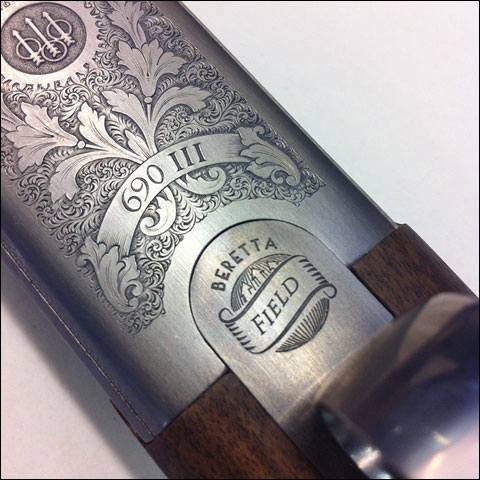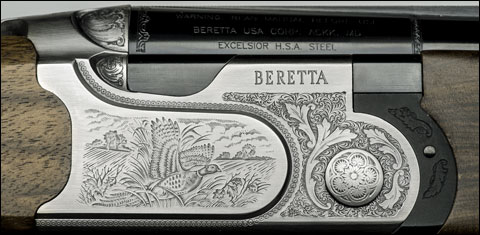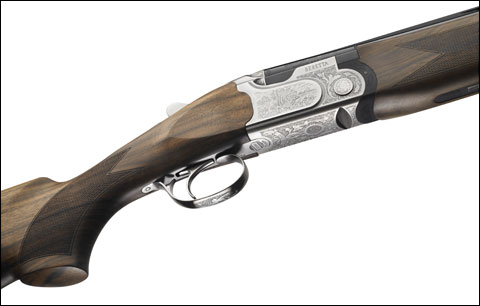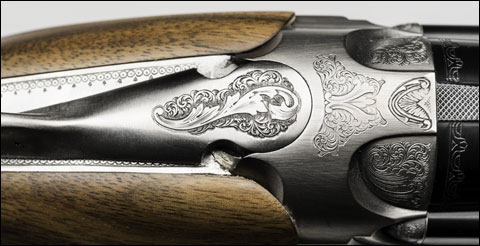Shooting the New Beretta 690 Field III Over/Under

Once the press conference is over in Tuscany, Italy and the pretty girl has held up the shotgun while everyone clamors around with a camera, there’s a much more defining moment. It’s the moment when the gun is in your hands, and the arm of the trap is cocked and loaded with the first clay you’ll shoot with it.
In that moment, there are a lot of considerations. First is the reaction to the gun on a visual level. I’m old enough to remember, and still own guns with hand cut engraving. While rolled engraving is attractive, I still like to see the crisp cuts of the real thing, cut by hand by humans with years of practice. One of my first impressions on the Beretta 690 Field III was just how good rolled engraving can look. I only carry reading glasses to see fine details, and I had to put my readers on to tell the engraving was rolled. The coin-finished, double-fenced receiver was well covered with a pleasing pattern that was attractive from any angle, no matter where you looked. Metal finish was bright and reflected time spent polishing before the metal was blued.

The oil finish on the wood of the Beretta 690 Field III was subdued, but with enough clarity to allow full appreciation of the high figuring and color of the wood. Wood-to-metal fit is about average for a gun of this grade. The wood is slightly proud, but as an owner of a lot of vintage guns, I know wood shrinks over long periods of time and the Beretta 690 Field III is certainly a fine enough gun to eventually become a family heirloom, reverenced in memory as part of a family’s history in the field.
My next impressions were tactile in the feel of the lever as it moved, the way the gun opened and closed. Of course, with any shotgun there’s the impression of balance of the gun between the hands. Our test guns had 28-inch barrels, a reasonable choice, since 28-inch barrels are most common on field guns. Although 26-inch barrels are also available, my choice for this gun would be 30-inch barrels. Thirty-inch barrels swing better and though they give up some handiness and light weight, at 7.3 pounds, the 12-gauge Beretta 690 Field III isn’t going to be the first choice as a Northwoods grouse or Georgia quail gun. I see the 12-gauge Beretta 690 Field III as a general purpose gun for preserve hunts, light waterfowl use, and recreational clays shooting, but Beretta did advise us the 20-gauge version of the Beretta 690 Field III is coming in 2015.

The Beretta 690 Field III employs Steelium barrels found on the 686 and A400 semi-auto. Steelium is Beretta’s proprietary alloy blend, which is 100-percent, cold-hammer forged. Steelium uses a long 65mm forcing cone.
The Beretta 690 Field III and 692 are both new over/unders that share the same “platform.” The Beretta 690 Field III is enhanced with aesthetic features while the 692 is enhanced with technical competition features for clays.
The receiver itself is the same internally, but where the 692 adds width for weight and has an understated sporty appearance design, the Beretta 690 Field III is thinner and lightweight with elegant engraving. The 692 has an overmolded top lever while the Beretta 690 Field III’s is engraved. Both have the same grade of attractive wood but the Beretta 690 Field III has more traditional field stock dimensions and is lighter in the hand. The 692 has the more robust stock and fore end with a pronounced palm swell on the stock. Finally the big difference is the barrels. The 692 uses the Steelium Plus forcing cone that you’ll find in the DT11, which extends it to about half way up the barrel at 360mm.
Five flush Optima Choke HP chokes come as standard equipment.
Rather than use an adjustable comb on a field model, Beretta has opted to offer the 690 Field III with different stocks. You can order the shotgun with either 35/55mm or 38/60mm drops in both cast-on or cast-off configurations with the semi-pistol grip. Beretta grades the wood at 2.5+.

Beretta’s 690 Field III can be ordered with different stock dimensions, all of which use the semi-pistol grip.
Our first target was a high left to right crosser. I took my place on the stand, pre-mounted the gun a couple of times, and called for a pull. The course of fire involved all singles except the last shot at each station and allowed utilization of the second barrel. I missed the first shot, jumping on the gun just as I pulled the trigger, and crushing it with the second. I describe this to emphasize the importance of good and consistent trigger pulls on shotguns. Everyone understands the value of a good trigger on rifles and pistols, but shotgun triggers are just as important. The rhythm of shooting flying targets requires full focus on the target, and a heavier than normal or gritty trigger can cause a flinch with better shooters.

High-quality engraving at the price point is evident from the top lever of the Beretta 690 Field III.
While the Beretta 690 Field III had excellent trigger pulls, both reasonably light for a field gun and crisp, the pull was a little heavier than the double triggered, William Palmer Jones live bird gun I normally use for clay shooting. After that first shot, I acclimated to the trigger. It was consistent and breaks at the same weight; exactly what’s needed in a field gun. On opening the Beretta 690 Field III after the first shots, the final impression was the sound of the sears clicking in and the plunk of the ejectors, which can be turned into extractors by turning a screw, a feature of the Eco Extraction system, first offered in the premium Beretta SV10 and 692, for those who prefer extraction over ejection.
While the specific fit of the guns I shot weren’t an exact fit for me, the cast off, lower comb version would have been a 50/50 gun for me, and that’s exactly what I prefer for general field use. Balance was good; the gun was fast enough, but still had enough muzzle weight to keep it moving on fast lateral shots like rabbits. In all, the Beretta 690 Field III Field is a versatile gun, capable of doing many things well, though limited in specialized pursuits.
According to Beretta officials, I’m assuming the Beretta 690 Field III/692 platform will be the basis of Beretta’s basic over/under line, eventually replacing the 686/687 product line. While the new Beretta 690 Field III picks up a little weight over the 687 platform, it’s still a reasonable field gun and the additional features make it a lot of gun for the money with pricing projected at $3,700.
Dick Jones began competitive shooting in 1976, winning his first practical pistol competition. He began shooting Hunters Pistol in 1979 and became a AAA shooter. He took up High Power Rifle in 1984 and took first Marksman in the state championship that year in his first match shooting an M14 rifle. He became a Master and captained the third place National Trophy Civilian Team in 1988, became a Distinguished Rifleman in 1991, a High Master in 1992, and Presidents Hundred in 1996. He was the 1,000 yard NC Service Rifle Champion in 1988 and 1989 and captained, coached, and fired on the winning service rifle 1,000 yard team those years. He captained and coached multiple national level teams both junior and senior, across the course and long range, from 1984 to 1996 at Camp Perry, Ohio.
He is an NRA Rifle, Pistol, and Shotgun Certified instructor, a North Carolina Hunter Safety Instructor and certified by the state of North Carolina to teach the Concealed Carry Handgun Certification course. He is also an award winning outdoor writer and writes for Gun Mag Magazine as a regular contributor as well as writing for other magazines, newspapers and WXII TV. He and wife Cherie own the Lewis Creek Shooting School. Visit the web site at http://lewiscreekshooting.com.
Useful resources:
The 690 Field III page on the Beretta web site

Dick Jones began competitive shooting in 1976, winning his first practical pistol competition. He began shooting Hunters Pistol in 1979 and became a AAA shooter. He took up High Power Rifle in 1984 and took first Marksman in the state championship that year in his first match shooting an M14 rifle. He became a Master and captained the third place National Trophy Civilian Team in 1988, became a Distinguished Rifleman in 1991, a High Master in 1992, and Presidents Hundred in 1996. He was the 1,000 yard NC Service Rifle Champion in 1988 and 1989 and captained, coached, and fired on the winning service rifle 1,000 yard team those years. He captained and coached multiple national level teams both junior and senior, across the course and long range, from 1984 to 1996 at Camp Perry, Ohio.
He is an NRA Rifle, Pistol, and Shotgun Certified instructor, a North Carolina Hunter Safety Instructor and certified by the state of North Carolina to teach the Concealed Carry Handgun Certification course. He is also an award winning outdoor writer and writes for Gun Mag Magazine as a regular contributor as well as writing for other magazines, newspapers and WXII TV.
He and wife Cherie own the Lewis Creek Shooting School. Visit the web site at http://lewiscreekshooting.com.


Comments